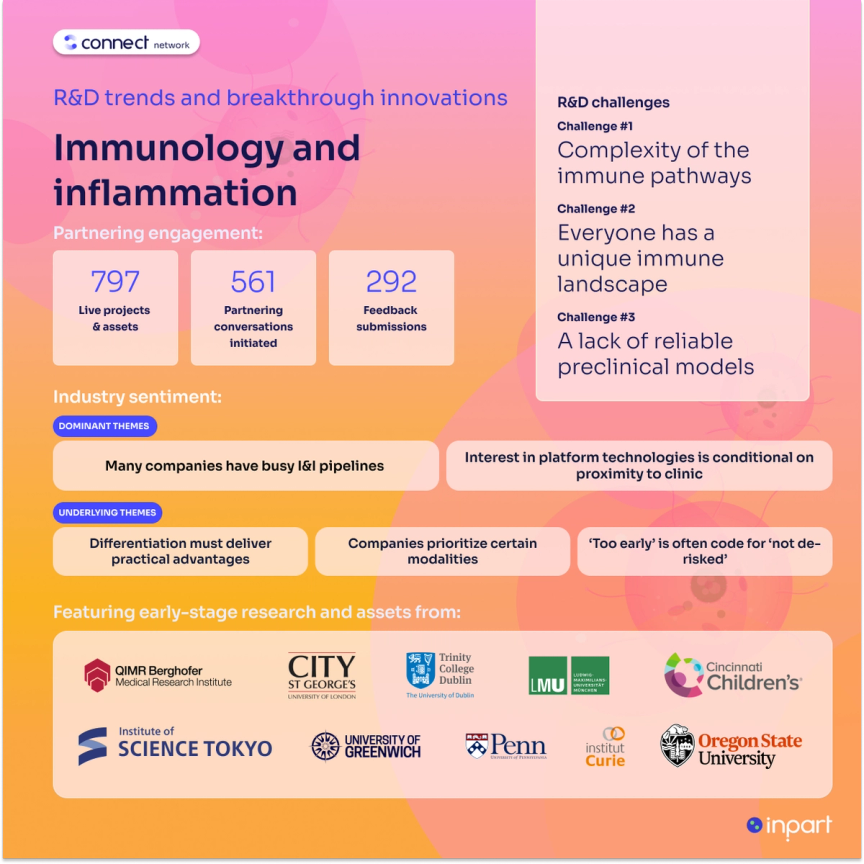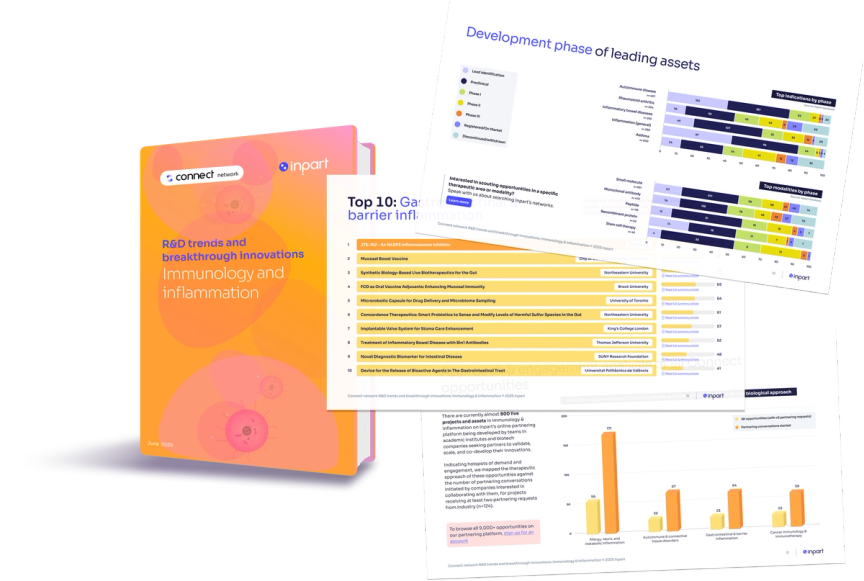Immunology & inflammation R&D trends and breakthrough innovations
This report identifies the latest trends in immunology and inflammation (I&I) R&D, providing scientific decision-makers with a roadmap of high-impact opportunities, emerging technologies, and potential future partners.
Inpart's R&D trends reports and online partnering platform aim to provide access to the most-promising, exclusive, and previously unsurfaced early-stage research and assets, helping accelerate the development of new I&I technologies and medical interventions.
About HUB Organoids: HUB Organoids is the global leader in patient-derived organoid technology. Their patented technology enables drug developers to identify and validate clinical candidates in a patient-relevant in vitro system.

Download the report
Key challenges for I&I R&D
Autoimmune and inflammatory diseases occur when our body’s innate immune response mistakenly targets healthy tissue. These often-debilitating conditions, including rheumatoid arthritis, IBD, lupus, COPD, and asthma, are increasing in prevalence worldwide. A recent Lancet study found that as many as one in ten people in the industrial world suffers from an autoimmune disease. With this, investment in immunology and inflammation (I&I) R&D is increasing, comprising some of the biggest deals in the pharmaceutical industry in recent years. Over $10 bn was invested in I&I R&D in 2024 alone, with many of the largest pharma companies acquiring biotechnology companies with I&I pipelines.
Four first-in-class I&I drugs have been produced since 2020, and the number of therapeutic assets in development for I&I targets has increased by almost 50% in the same timeframe. Despite the increasing research output and new wave of investment, R&D in I&I still faces challenges that must be navigated.

R&D challenge #1
Complexity of immune pathways
The immune system is vastly complex and interconnected. Blocking a specific pathway can have a knock-on effect on the immune response to other threats. It is also thought that immune system redundancy (the overlap in function of multiple pathways or components) is responsible for reducing the efficacy of potential I&I therapeutics by aiding immune resilience.
R&D challenge #2
Everyone has a unique immune landscape
Autoimmune diseases and chronic inflammatory conditions exhibit clinical heterogeneity across patient groups, with genetics, environment, and microbiome composition all contributing to how different diseases present and progress. Universal biomarkers are lacking, making it hard to predict disease onset and therapeutic responses in I&I patients.
R&D challenge #3
A lack of reliable preclinical models
Animal models don't always accurately predict the immune response of humans, with frequent discrepancies in cytokine signalling, differing microbiomes, and disease progression. This is thought to be a key cause of translational failure when moving into human clinical trials for I&I therapeutics. Next-generation preclinical solutions are emerging such as humanized mouse models and organoids.

The role of organoids in immunology & inflammation R&D
Progress in immunology and inflammation R&D is often limited by preclinical models that inadequately capture the complexity of human disease. Patient-derived organoids are helping overcome these limitations by offering closer representations of human biology and complex cellular interactions between organs.
Listen to an audio digest of the editorial and report introduction
Top I&I innovations
Review the highest performing immunology and inflammation projects and assets from our online partnering platform.
To read the summary article of each project and to connect with the team developing them, you will need to join our online partnering platform.

1. A potent NLRP3 inflammasome inhibitor
Inflammasome-driven diseases such as inflammatory bowel disease (IBD) represent a major challenge in immunology, where overactive immune signaling causes chronic inflammation and tissue damage. Central to this pathology is the NLRP3 inflammasome, a molecular complex that triggers the release of inflammatory cytokines such as interleukin-1 beta(IL-1β) upon sensing cellular danger signals.
Developed by scientists at JT Pharma, JTE-162 is a highly selective small molecule inhibitor of the NLRP3 inflammasome, which is now in Phase 1 trials. It has demonstrated potent IL-1β suppression in preclinical models, outperforming benchmark inhibitors while showing no off-target effects on related inflammasome subtypes. With strong oral bioavailability, selective action outside the brain, and a clean safety profile in toxicology studies, JTE-162 is well positioned as a differentiated treatment for peripheral inflammatory conditions such as IBD.
2. A master switch for treating autoimmunity
Autoimmune diseases remain difficult to treat, especially when therapies target individual inflammatory signals. Conditions like Sjögren’s syndrome, where single-cytokine blockers show limited benefit, highlight the need for alternative ways to recalibrate immune responses without triggering systemic immuno suppression.
Work by researchers at the QIMR Berghofer Medical Research Institute, now being developed by spin-out company Fovero Therapeutics, introduces a new class of immunotherapy based on fully human anti-Galectin-9 antibodies. Their lead asset, FT024, operates via a “master switch” mechanism -inhibiting activity in cytokine-secreting cells rather than blocking specific cytokines. This nuanced approach to modulation reduces inflammation across multiple pathways while preserving essential immune functions. With early promise in Sjögren’s syndrome and similar autoimmune conditions, this platform could redefine how chronic inflammation is managed across multiple diseases.
3. AI-driven antibody design
Designing effective antibodies against complex or elusive targets remains a critical bottleneck in drug development. Traditional discovery methods are often time-consuming, costly, and limited in scope, particularly when tackling membrane-bound or disordered proteins.
The SentinusAI® platform, developed by scientists at Ainnocence, offers an AI-driven alternative to antibody design, integrating epitope mapping, de novo design, and optimization to generate and refine high-affinity antibodies at scale. Capable of virtually screening up to 10¹⁰ candidates in a matter of days, the SentinusAI® platform delivers humanized, high-hit candidates with strong therapeutic promise across diverse indications. By accelerating development while cutting costs and reducing reliance on animal models, this platform is reshaping how biologics are discovered and optimized.
4. Building mucosal immunity against respiratory viruses
Conventional vaccines can struggle to halt transmission of respiratory pathogens due to the limitations of mucosal immunity, leaving populations vulnerable to rapidly evolving viruses such as SARS-CoV-2. Despite the respiratory nature of such diseases, no inhalable vaccines are currently licensed, highlighting a gap in preventive strategies.
Work from researchers at St George’s, University of London introduces a protein-only, aerosolized vaccine that targets mucosal tissues in the lungs and gut, generating a robust immune response at the site of pathogen invasion. Delivered via inhalation and produced using plant or mammalian systems, the platform is cost-effective, needle-free, and easily scalable. This approach offers a promising path to faster, more accessible vaccination campaigns and improved protection against a wide range of mucosal infections.
5. A new therapeutic route for inflammatory skin diseases
Inflammatory skin diseases such as generalized pustular psoriasis can be debilitating and difficult to treat, often driven by overactive immune signals that current therapies fail to adequately target. Dysregulation of IL-36 cytokines is increasingly recognized as a key driver of skin inflammation.
Researchers at Trinity College Dublin have developed novel polypeptide inhibitors that prevent the activation of IL-36α, β, and γ by targeting the proteases responsible for their maturation. By halting this activation step, the peptides suppress downstream inflammatory responses at the source. Applied topically, these inhibitors offer a promising therapeutic route that minimizes systemic side effects, opening new possibilities for precision treatment of IL-36-driven skin conditions.
6. Scalable inhalable RNA therapeutics
RNA-based therapeutics for pulmonary diseases face delivery and stability challenges, especially when administered systemically, where liver accumulation and short shelf-life limit their efficacy. Local administration via inhalation presents an opportunity to directly access the lung, yet stable RNA formulations for this route remain underdeveloped.
Researchers at LMU Munich have created RNhale, a spray-drying platform that converts RNA-loaded nanoparticles into inhalable dry powders with preserved bioactivity and extended shelf-life. By optimizing excipients, drying conditions, and tubing materials, the team has achieved strong results in ex vivo lung tissue models without inflammatory responses. Their platform supports scalable RNA drug production with potential to treat lung diseases like asthma, fibrosis, and respiratory infections.
Advance your partnering strategy
Speak with our experts to review your partnering goals and learn how our network, solutions, and tools can help accelerate your research and innovation.